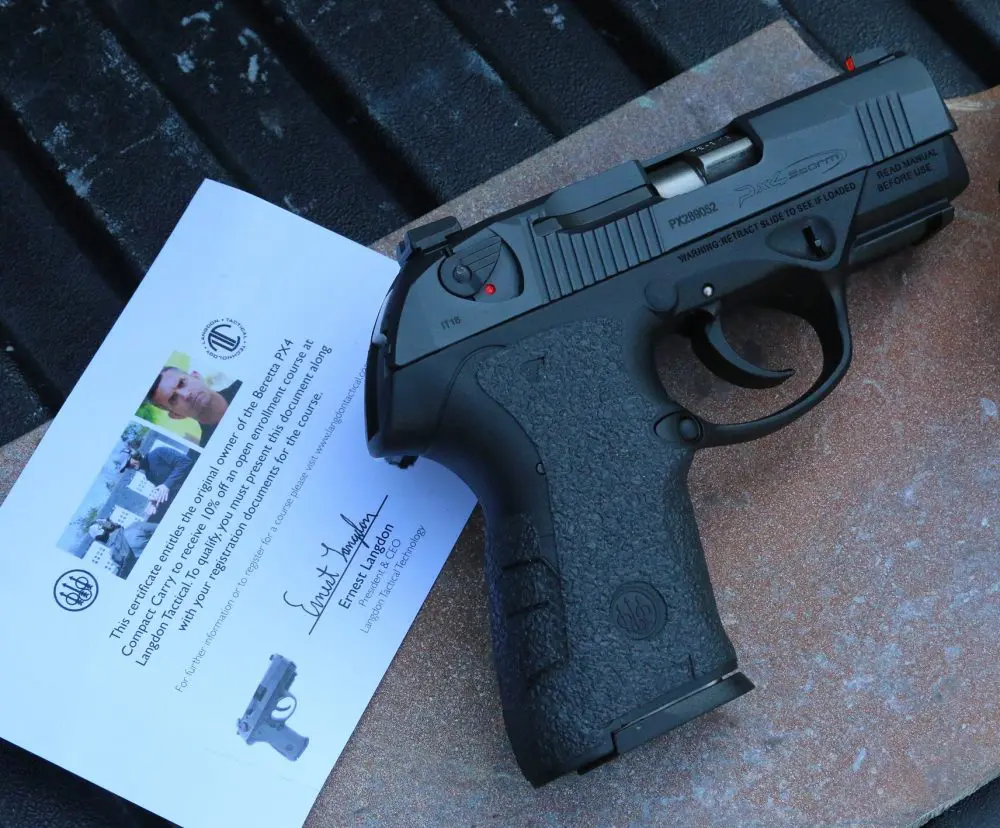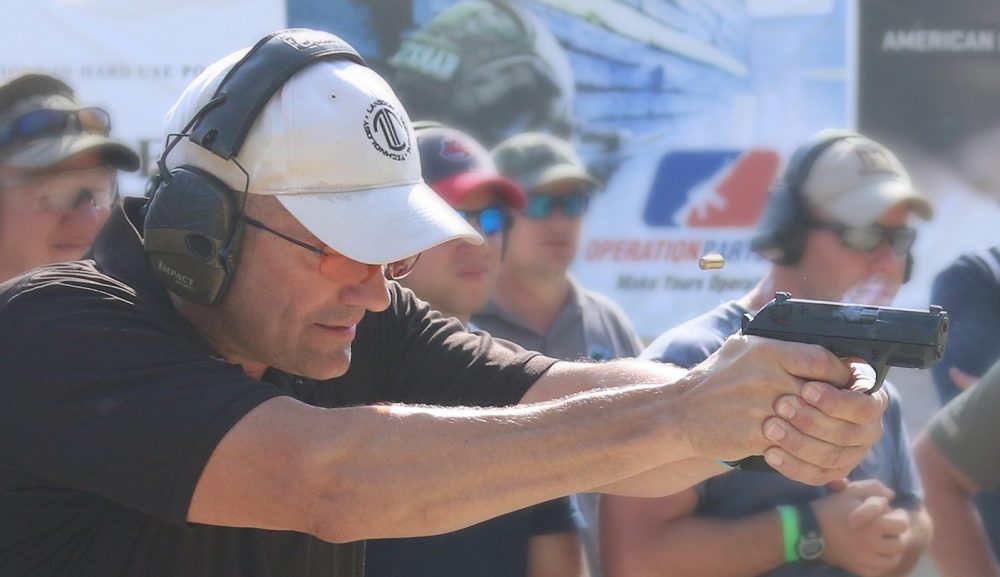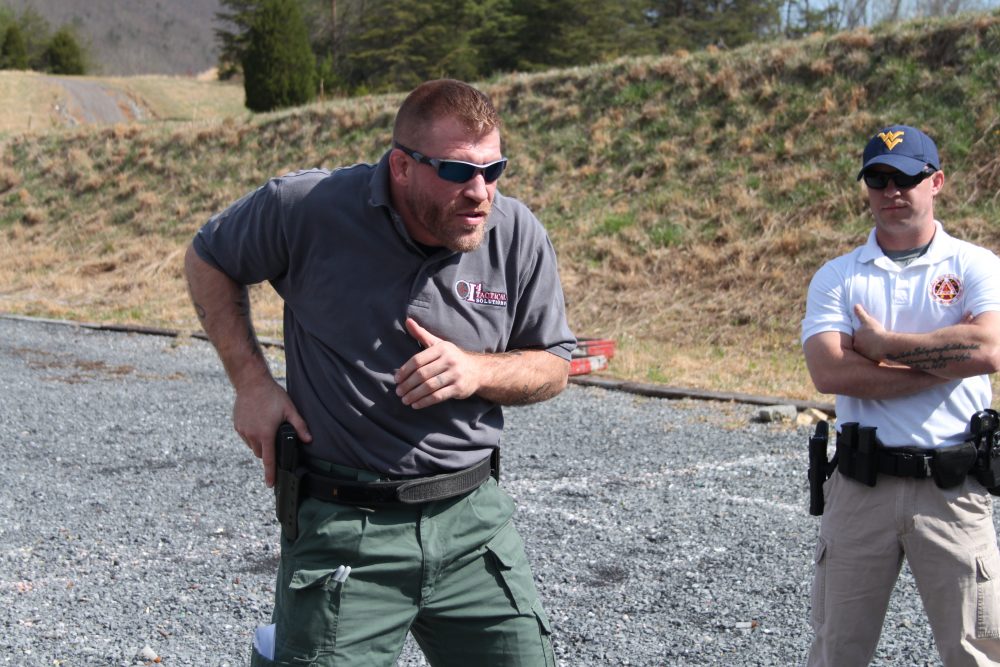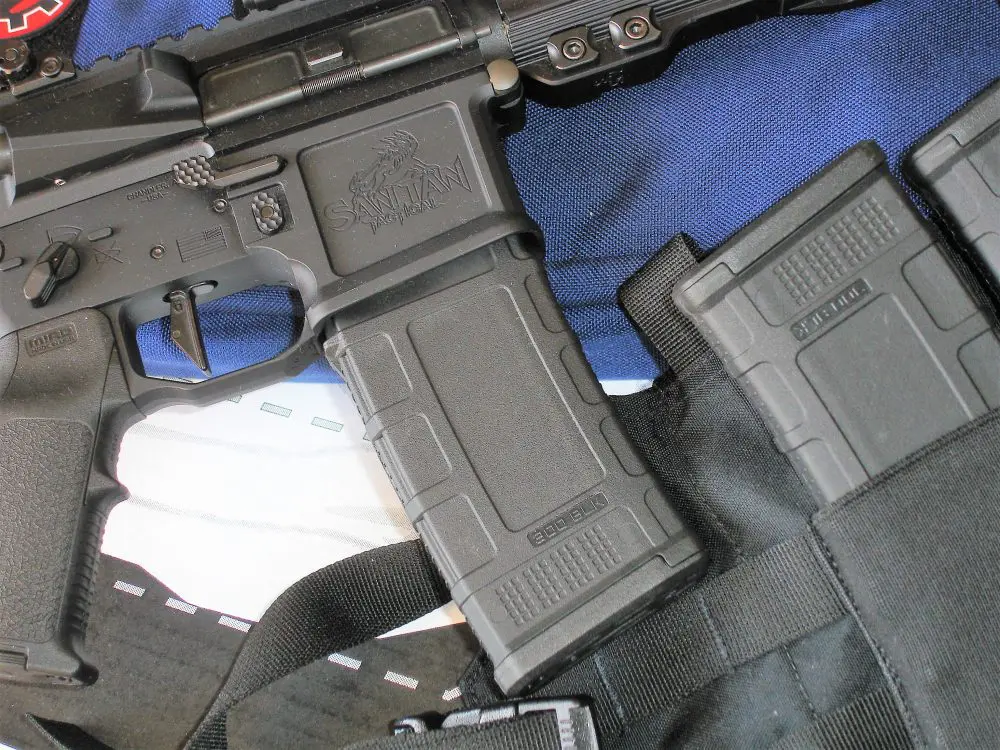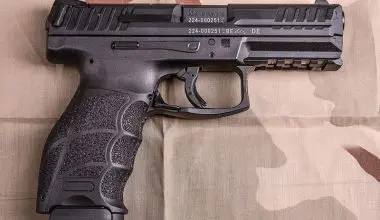Ernest Langdon demonstrates with PX4CC at a class. Langdon was driving force behind this special edition and spec’d each feature.
Spoiler Alert! Beretta Wins!
The Beretta PX4 Compact Carry is a special edition of a 15-shot double-action, polymer-framed 9mm that you have probably never heard of.
I can’t even tell you how long the PX4 has been on the market, but like much of the shooting world, I had never noticed it until my friend Ernest Langdon starting messing with one.
Ernest, a Marine vet, professional trainer, and many times champion shooter, wanted a “Glock 19-sized” option in a lightweight Double-Action/Single-Action (DA/SA) gun. Langdon made his competitive name beating all comers with DA/SA Berettas and SIGs, and is a strong proponent of the operating system.
He not only likes the inherent shootability of that trigger system, but as importantly the additional safety of reholstering a DA gun into an appendix holster. (The shooter can ride the back of the hammer with their thumb while reholstering, virtually eliminating the possibility of accidentally triggering a shot.)
He happened upon the PX4 Compact after years of ignoring it himself and started tinkering. The happy result is this article.
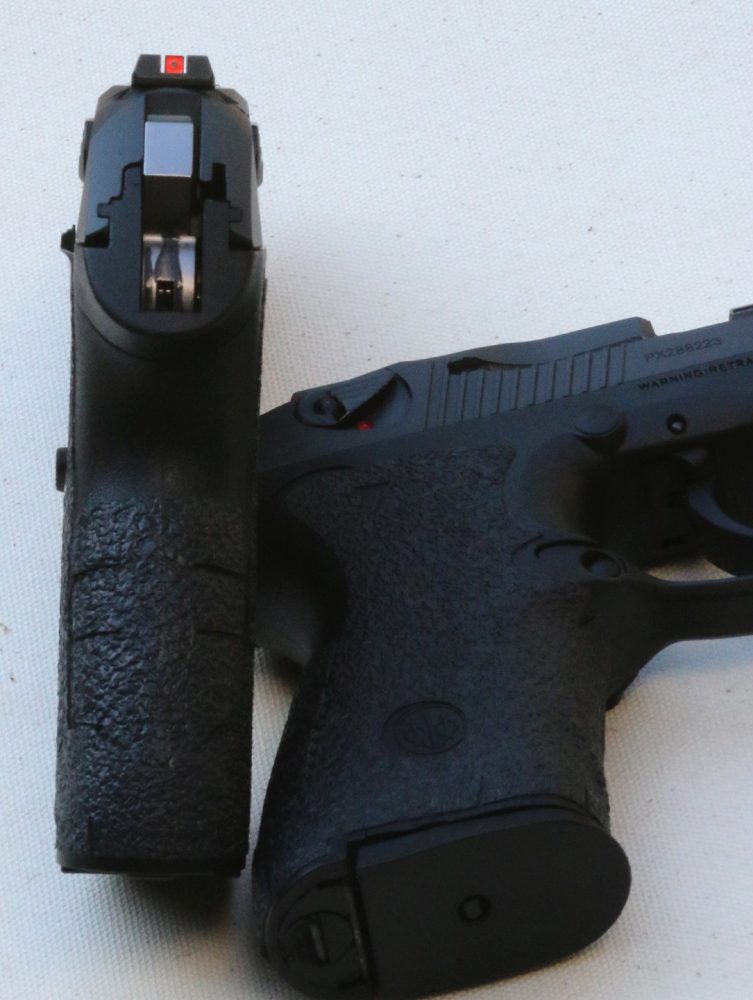
Ernest found a tremendous amount of potential in the PX4 Compact lying underneath a base layer that screamed out for refinement. He worked with Beretta to streamline the controls for concealed carry, improve the trigger, design some sights in conjunction with Ameriglo, and address the texture of the frame with Talon Grips.
The slide was given a unique Sniper Grey CeraKote. The package includes a credit toward one of Langdon’s Pistol Classes. These are the distinctions between a Compact Carry and a standard PX4.
Table of Contents
CC SPECS
The Compact Carry is squarely in the size envelope defined by the Glock 19. It weighs 27 ounces unloaded and is thick at 1.4 inches across the thickest portion. The grip gives most shooters a solid, full firing hand grasp, and the pistol carries interchangeable-sized backstraps to adjust fit. I have been running the medium and find it covers a wide range of hand sizes comfortably.
The barrel is a unique rotating lock-up that Beretta also used on the Cougar series. The pistol unlocks as the visible locking lug rotates about 30 degrees counterclockwise, leaving the barrel in the same horizontal plane, unlike the vast majority of competing designs, which tilt their barrels downward to unlock.
The rotating barrel allows the PX4 to feed with the rounds needing very little upward movement from the magazine, almost seeming to feed straight in at a casual glance. The arrangement changes the recoil impulse considerably and in a good way. There is remarkably little muzzle rise, even though “bore axis” on the gun is fairly high. I think it would be impossible to fire the Compact Carry and not immediately notice how “soft” and “flat” it shoots.
The lock-up also certainly seems to work, as I was able to put five of Hornady’s new Steel Match 125-grain HAPs into right at an inch. The other Steel Match groups averaged 1.16 for five at 25 yards and reinforced that this wasn’t a fluke. Black Hills 115-grain FMJ poked a 1.6-inch group, and a wide variety of others did under 2.5 inches.
Most groups had four impressively tight and one outlier opening to over two inches. I’m hard pressed to say whether that was the gun or a consistent lack of discipline on my part, but several groups across brands were about 1.5 inches for four shots. The little pistol shoots.
TRIGGER
The competition trigger pack in the Compact Carry helps you get to the accuracy. The DA is reminiscent of a 92F or M9 that has had skilled trigger work, but better. I really liked the DA on this pistol. I spent time in a unit where the men ran Berettas at a very high level of skill, so I’m well acquainted with a 92-style trigger.
This one is buttery smooth all the way through and was just off of my eight-pound gauge. I guesstimate it drops the hammer at a fraction over nine pounds. The single action is 4.2 pounds. I found the SA to have a great blend of tactile take-up to prepare the shooter and serve as a warning, then a crisp release with no overtravel. The trigger is by far the best DA/SA I’ve shot on a factory gun.
I know it’s fashionable at the moment to default to striker-fired guns and overlook DA/SA models. This is the trigger you need to try before forming hard-set biases about DA/SA guns.
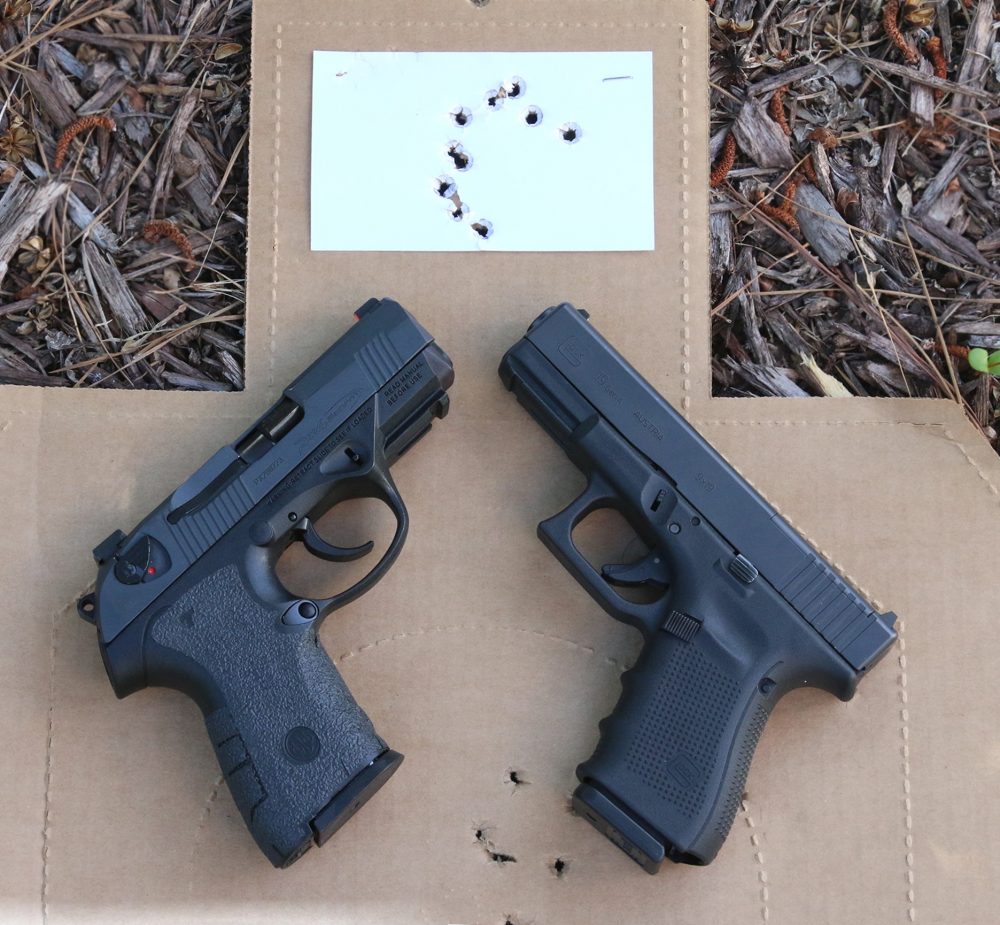
Food for thought: I put the Compact Carry against a Glock 19 for a single shot from the ready to a 3X5 card in the head of a target at seven yards. As prelude, I might note that I’ve been overwhelmingly shooting striker-fired guns for the last few years.
The Beretta averaged .66 second to punch the card—the Glock .82. The slowest time with the PX4 (.74) matched the fastest time with the stock 19.
A great DA trigger allows a higher-end shooter to combine the attainment of sight alignment with the trigger pull, as the pistol glides into full extension to a degree that isn’t possible with a striker-fired trigger. And that is the “difficult” DA press. You’re then into the remaining shots with a great single-action release.
The DA pull on the Compact Carry was good enough to invite exploration of its limits. With a magazine of Hornady Steel Match to remove any accuracy-related excuses, I took on a Defense Targets Ready Ship reduced silhouette at 70 yards.
Single shots double-action were fired from the ready. Attempting to smoothly cycle the trigger with no staging, I was mentally trying to beat 1.5 seconds to get a hit.
My average over a string of consecutive hits was 1.12. There’s no blaming the DA trigger for a miss when it’s this smooth. Stretching out to 90 yards, I leaned over the truck tonneau cover and carefully staged the DA through the cycle slow fire. The HAPs “bonged” steel four out of six attempts.
I’m giving a lot of credit to the trigger, but the sights played a significant supporting role in how well the PX4CC shoots. They feature a prominent orange paint fill surrounding a tritium capsule while leaving a thin but distinct black top line for precision alignment. The rear notch is wide and somewhat deep. The sights are plenty precise and wickedly fast to acquire in most lighting.
CONTROLS

The Compact Carry is a “G” model in Beretta-ese, meaning the slide-mounted lever acts as a decocker, dropping the hammer safely to return the pistol to DA mode, but not staying down as a safety as with the M9.
This model carries the “stealth” levers extending just barely past the slide and not at all noticeable or obtrusive in carry or use. I have long thumbs and have no issues reaching up and finding the lever to decock the little 9mm, but it might be a more deliberate effort for shooters with smallish hands.
The slide release is situated perfectly for a strong-hand thumb release and, like the decocker, is as tight to the pistol’s profile as possible without sacrificing function. These are both noteworthy departures from the stock PX4, whose controls are quite oversized.
The package comes with three differently sized magazine releases. I found them to fall easily under the thumb and release well. Overall the controls are immediately familiar to anyone who has spent much time with a 92FS/M9. I was impressed with how well situated and fast they were to function for such minimalist, low-profile parts.
It may have been all of the Beretta time coming back to me, but I was getting slide-lock reloads to just over 1.5 seconds within the first few attempts. I typically lose some time with compact pistols where the bottom of my hand overhangs the end of the pistol’s grip, so I was very pleased.
Using a Beretta +3 adapter on the compact mags for the reload helped even more. There is a noticeable difference in how smoothly the PX4CC was back onto target when dropping the slide. I attribute this both to the rotary lock-up and feed angle.
RANGE TIME

Cutting to the chase, I have never picked up an unfamiliar pistol and shot it as well as I did the PX4 Compact Carry. With the factory gun, I equaled personal bests that were set with full-size service pistols tweaked to my liking, and I set a stack of new personal bests with the custom LTT/ROBAR Mod 4 (see sidebar). Both guns outran stock compact and service pistols handily.
For example, I like to use the ten-yard plate rack as one of my baselines: six eight-inch steel plates from the ready. With stock service pistols, I am usually happy to break three seconds by a tenth or so. With a personalized set-up, I am actively trying to break 2.5 seconds, but am not consistently successful.
The Compact Carry zapped six plates repeatedly in about 2.4, and I shaved some more with the Mod 4, laying down a clean run in 2.27. I credit this to a happy intersection of a pistol that points well, low muzzle rise, great trigger with short reset, and high-visibility sights.
Another baseline I’ve started using is two shots from the ready to a Defense Targets “Noner” steel plate and then immediately transitioning to the “hostage taker” type six-inch flipper at seven yards. With stock service pistols or personalized compacts, I expect to beat 1.25 seconds. It is a close and fast drill that gives me a good sense of how quickly I can acquire and break the first hit, follow up, and drive to a moderate-difficulty hit.
Using SuperVel Hush Puppy subsonics, the Glock 19 was running 1.15 seconds with little deviation. The Beretta launched fast and sprinted to a .96 average. The Mod 4 both set a new best for me and averaged .88.

The Compact Carry smoked the five-yard roundup, an aggregate of four 1.5-second strings from the holster, ready, strong, and support hand only, posting 15 hits at best and 14 consistently with Federal’s new Train and Protect hollow-points. This is three to four hits ahead of most compact guns for me, which is a pretty huge gap across four strings.
I’ve got more data than space to recount it, but the takeaway is that the PX4CC shoots remarkably well. I’m almost a little confused at how a compact-carry pistol can shoot so well in comparison to full-size pistols. It breaks the convention for sure.
I can shoot a Glock 19 or an M&P Compact well, but not as well as their big brothers. To outshoot all of the above with a compact gun that I have limited rounds through is remarkable.
For that to be a gun few noticed or took seriously is almost embarrassing. You don’t often get a great-shooting gun and a life lesson about jumping to conclusions or judging things by appearances….
CARRY
PX4CC is a perfect match to appendix carry, as in this JM Custom holster.
I’ve now got about 800 rounds through the Mod 4 and about 650 through the factory PX4CC problem free. I’ve been carrying them in a JM Custom Kydex Appendix IWB holster, and they carry well and comfortably. The contours of the grip and slide rear actually print less than most of the striker-fired genre.
Holster support is available, but not widespread, so options are somewhat limited. I’ve been using a Blade-Tech belt holster and am about to try a Ready Tactical OWB model as well.
I’ve been carrying the Berettas with the Black Hills Honey Badgers on board. The load groups well and as a standard-pressure subsonic has very low recoil but outsize performance due to the bullet design.
The Talon Grips rubbery wrap-around panel is working well to date and is comfortable against the skin in carry. The factory texture is ho-hum at best, so the Talon grip is a distinct plus. I’m well into humid East Coast summer, and it’s holding up, although I consider it an expendable part that will likely require replacement at some interval.
DRUTHERS
If you’ve read this far, you’re probably getting the sense that I am enthused about this model. Indeed I am. But two areas I accept rather than appreciate.
The first, as hinted earlier, is the texture. The checkering fore and aft is good, but the sides of the grip are slick and could use serious improvement. The fact that the package includes a Talon Grip basically acknowledges this.
The second is that the accessory rail does not accept many of the standard weaponlights on the market. Not a huge issue to many prospective customers, but worth noting.
Beretta has been on a roll for the last year or so, and the PX4CC is a perfect example of a company listening to experts to refine a model.
If you’re in the market for a compact, give this one a serious look!
SOURCES
BERETTA U.S.A. CORP.
(800) 237-3882
www.berettausa.com
LANGDON TACTICAL TECHNOLOGY
www.langdontactical.com
ROBAR GUNS
(623) 581-2648
www.robarguns.com
BLACK HILLS AMMUNITION
(605) 348-5150
www.black-hills.com
BLADE-TECH INDUSTRIES
(877) 331-5793
www.blade-tech.com
FEDERAL PREMIUM AMMUNITION
(800) 379-1732
www.federalpremium.com
HORNADY MFG. CO.
(800) 338-3220
www.hornady.com
JM CUSTOM KYDEX
(775) 686-8431
www.jmcustomkydex.com
READY TACTICAL
www.skdtac.com
TALON GRIPS
(970) 879-9600
www.talongrips.com
CUSTOM LTT/ROBAR Mod 4
While I was testing the factory special-edition PX4CC, Ernest Langdon sent out one of his custom Langdon Tactical Technology (LTT) guns—a Mod 4. This is where he takes the Compact Carry and upgrades it further.
This package includes Ernest doing a complete trigger job and ROBAR plating the barrel, action parts, and magazines with NP3. The hammer on this sample had been converted to spurless.
The DA on the Mod 4 was silky smooth all the way through and measured 7.7 pounds. This trigger can change your mind about DA and take a double-action-ero to a higher plane of being.
I was skeptical that the NP3 would do much other than add protection and extra time between lubrication, but I found that the pistol cycled and locked noticeably more smoothly than its counterpart (which was already impressively smooth).
Basically, the LTT Mod 4 took everything great about the Compact Carry and enhanced those areas an extra notch or two. The Mod 4 ran a little ahead of its brother on almost every drill, so the custom touches translated to performance on an already high-stepping model. The Mod 4 is finished off with an LTT logo laser engraved on the top of the slide just ahead of the rear sight.

